MIT’s David Hill, a PhD student in media arts and sciences, builds computational models of human locomotion, which are the basis for designing ever-better prosthetics and his advisor, Hugh Herr, an associate professor of media arts and sciences, is a double amputee.
Hill says living in the world of theoretical models can be somewhat insular, so having a real-life example of someone who can benefit from and pilot some of the work he does is part of what helps him stay focused. Human movement is a complicated and often taxing activity, though, even for healthy people. Support from robotic wearables could help make the work of soldiers, construction workers, and other heavy lifters less physically detrimental.
In Herr’s lab, Hill is currently working on modeling the lower extremities during walking. It sounds like a narrow project, but the lab’s focus is on creating robotic devices that mimic biological function as closely as possible. Hill’s model has to account for every minute angle and movement throughout the legs, from the hips all the way down to the joints in the foot. When completed, the model will be used to propel designs for mechanical devices for any part of the lower body, and for a myriad of uses.
Hill’s true passion, however, is sports science. Growing up in western Tennessee, he could usually be found on the basketball court or baseball field. Although he always dreamed of becoming an athlete, he knew early on that his real talents were elsewhere. “I wanted to be an athlete so badly,” Hill says. “But I knew it just wasn’t in the cards, so I decided to find another way to stay part of that world.”
Now he aims to use his computational modeling skills to build assistive devices for athletes. Whether the devices help rehabilitate injured players or mitigate some of the physical stresses of athleticism, Hill has his eye on keeping sports a regular part of his life. Hill attributes much of his journey toward robotics to the mentorship he received.
For more information please visit: www.phys.org

